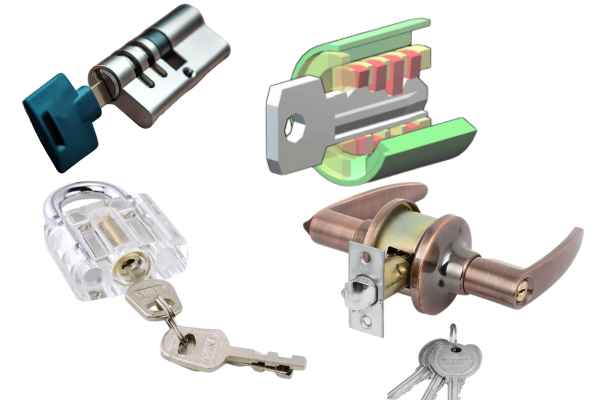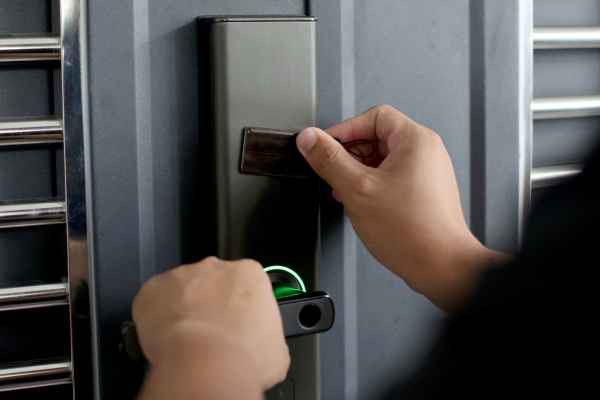How Do Door Locks Work?
Door locks play a crucial role in maintaining safety and privacy in our daily lives. They serve as the primary line of defense against unauthorized access, effectively safeguarding homes, offices, and personal spaces. This article explores the intricate workings of various types of door locks, ranging from traditional mechanical designs to advanced electronic and smart lock technologies. We’ll break down the components and mechanisms that enable locks to secure doors effectively, providing a clear understanding of how these essential devices function. Understanding the mechanics of how do door locks work. That not only increases our appreciation of their role but also helps us make informed decisions about our security solutions.
Key Components of Mechanical Door Locks
Core Mechanism: The Lock Cylinder

The most important component of door locks to work is the lock cylinder When you insert and turn a key, it aligns internal pins or tumblers to a specific height, allowing the cylinder to rotate freely. This rotation is crucial, as it triggers the lock’s mechanism to either engage or disengage, locking or unlocking the door accordingly.
The Pins and Tumblers
Central to the function of the lock cylinder are the pins and tumblers. These small yet vital parts work in tandem to secure the lock. In a typical pin tumbler lock, several pairs of pins prevent the cylinder from turning unless the correct key is inserted. Each key, uniquely cut, raises each pin pair to align perfectly at the shear line when inserted, clearing the way for the cylinder to turn.
Latch and Bolt Action
Once the cylinder turns, it activates the latch or bolt—the physical barrier that extends into the door frame, securing the door. The latch or bolt retracts when the cylinder turns one way and extends when turned the opposite way. This simple yet effective mechanism ensures that the door remains locked or unlocked based on the position of the latch or bolt, providing a reliable means of controlling access.
Types of Mechanical Door Locks
Most of the cases, every type of door locks work in the same way. But there are various types of door locks. They are:

1. Pin Tumbler Locks: The Common Choice
Pin tumbler locks, prevalent in residential settings, utilize a series of pins divided into pairs. Each pin pair must align correctly with the key’s unique cut to unlock. This mechanism offers a high level of security due to the complexity and variety of pin configurations possible, making it difficult to pick or manipulate without the specific key.
2. Wafer Tumbler Locks: Versatile and Reliable
Wafer tumbler locks, commonly found in vehicles and file cabinets, feature single-piece wafers that function similarly to pins in pin tumbler locks. The key’s insertion raises or lowers these wafers to align correctly, allowing the lock cylinder to turn. Their simplicity and reliability make them a favored choice for less security-intensive applications.
3. Lever Locks: Durable and Secure
Lever locks, often used in commercial buildings, require the key to lift a set of levers to a specific height to unlock the mechanism. This type of lock is known for its durability and significantly resists tampering and forceful entry, providing an added layer of security in environments that require robust protection.
4. Disc Detainer Locks: Advanced Security
Disc detainer locks offer advanced protection with a set of rotating discs, each requiring the key to align them at an exact angle. This design’s unique mechanism makes it harder to pick, often making it the choice for high-security applications like bicycle locks and padlocks.
Understanding the variety and functionality of mechanical locks can significantly aid in choosing the right lock type for specific security needs, whether for personal, commercial, or specialized use.
Advancements in Electronic Lock Systems

Transition to Digitized Security
Electronic locks represent a significant advancement in door lock technology, moving beyond mechanical components to incorporate digital elements that offer both flexibility and enhanced security. These locks typically utilize keypads, magnetic cards, RFID technology, or biometric sensors instead of traditional keys, providing a keyless entry system that can be more convenient and secure.
Customizable Access Features
A major advantage of electronic locks is their ability to be programmed with temporary or permanent codes and access permissions. This capability allows homeowners and businesses to control who enters and when, with the ability to easily change codes instead of rekeying traditional locks. Additionally, activity logs can be reviewed to track entries and exits, an invaluable feature for maintaining security in sensitive environments.
Integration with Smart Home Systems
Further enhancing their utility, many electronic locks can integrate seamlessly with smart home systems. This integration permits users to lock and unlock doors remotely using smartphone apps, check lock status in real-time, and receive notifications of door activity. Some models even support voice commands through AI assistants like Amazon Alexa or Google Assistant, adding a layer of convenience to the robust security features.
Biometric Systems: The Future of Security
Biometric locks, which use unique physical characteristics such as fingerprints or facial recognition, are at the forefront of electronic lock technology. These systems provide a high level of security by ensuring that only registered individuals can unlock the door, virtually eliminating the risk associated with stolen or lost keys.
Overall, the advancements in electronic lock systems offer a compelling blend of convenience, control, and security, making them an increasingly popular choice for those looking to upgrade their door security systems.
The Role of Smart Locks in Modern Security

Enhancing Security with Connected Features
Smart locks are at the forefront of modern home security, integrating advanced technology to enhance safety and convenience. These locks connect to the internet, allowing users to control access to their homes remotely through smartphones or other smart devices. This connectivity provides significant benefits, such as the ability to lock or unlock doors from anywhere in the world, which is especially useful for granting temporary access to guests or service personnel without providing a physical key.
Customization and Monitoring Capabilities
One of the standout features of smart locks is their ability to send real-time alerts and updates about door status, ensuring homeowners are always aware of who is entering or leaving their property. Moreover, many smart locks offer extensive customization options, including setting schedules for when certain individuals can access the property, further enhancing the control homeowners have over their security.
Seamless Integration with Home Automation Systems
Smart locks also play a crucial role in comprehensive home automation systems. They can be programmed to interact with other smart devices, such as lights and security cameras, to create a fully integrated, automated security system. For example, unlocking a smart lock can trigger hallway lights to turn on and security cameras to start recording, providing an added layer of security and convenience.
Future Prospects and Innovations
As technology evolves, the capabilities of smart locks continue to expand. Future developments are likely to include even more sophisticated encryption methods to prevent unauthorized access, deeper integration with home IoT ecosystems, and more intuitive user interfaces, making smart locks an indispensable component of modern home security.
Smart locks are transforming the landscape of residential and commercial security, offering not just improved safety but also a wealth of features that cater to the dynamic needs of modern lifestyles.
Conclusion
In conclusion, the evolution of door locks from mechanical to electronic and smart systems reflects significant advancements in security technology. Each type of lock, from the traditional mechanical locks with their robust, simple designs to the highly customizable and integrated smart locks, serves a distinct purpose and offers specific benefits. Understanding these mechanisms is crucial for anyone looking to enhance the security of their home or business. By choosing the right lock, you can ensure not only the safety of your premises but also enjoy greater convenience and control over access. As we continue to embrace technological innovations, the role of door locks as the first line of defense in security is not only preserved but also strengthened, providing peace of mind in an increasingly complex world.
